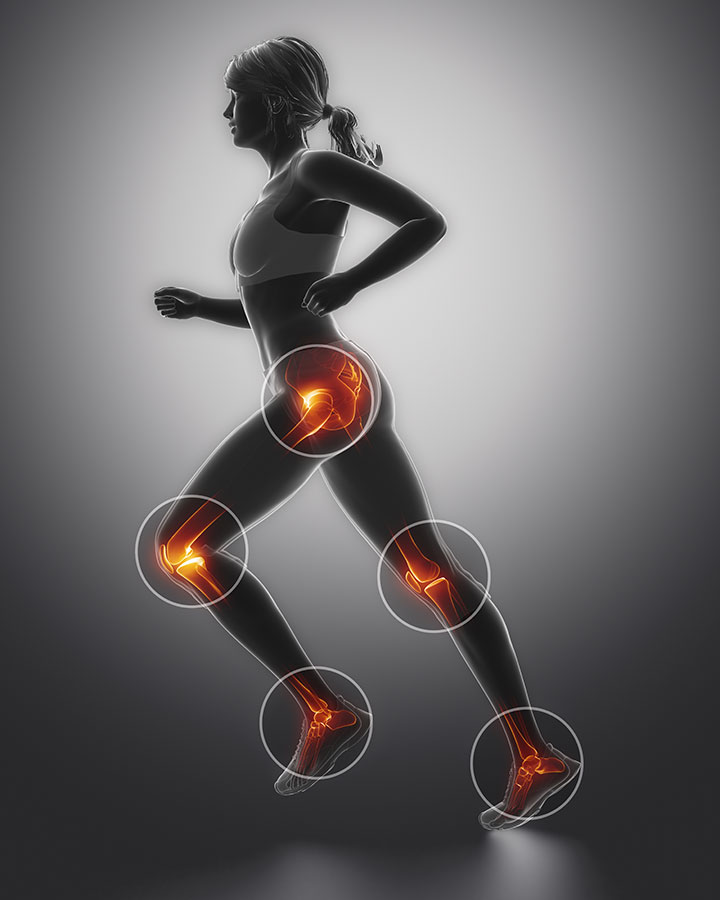Runner’s knee falls under an umbrella term which includes various conditions that may cause pain in and around the knee cap or patella. As the name suggests runners is the most common people who would suffer from this type of pain, extraneous activity where the knee is excessively bent under load will cause you experience pain while running.
These conditions include anterior knee pain syndrome, patellofemoral malalignment, chondromalacia patella and iliotibial band syndrome (ITB).
Symptoms
- A Dull ache around or behind the knee cap (Patella)
- Pain especially over the quadriceps insertion on to the top of the patella or the lower part of the thigh bone
- You will be able to elicit the pain when walking, running
- Standing and bending both knees like when doing a squat
- Direct pressure will be painful like when kneeling on the knee
- The pain will be worse when walking down stairs or descending a hill
- Swelling may be present
- Pain after sitting for a long time with the knees bent
- Popping or grinding sensation in the knee

How Runner’s knee develop
The strain put on the patella causes a compression in the femoral Groove. The higher the load on the quadriceps the greater the compression on the patella. The excessive pull on the quadriceps tendon on the top part of the patella can start tearing the tendon fibers. The downwards compression of the back part of the patella onto the femur will over time erode the cartridge and reduces its shock-absorbing function. This compression force is exacerbated when the quadricep muscle is shortened. If the quadriceps muscles are weak it could cause a sideways pull on the patella that can cause the patella to run towards the in or outside that may run down the cartilage much faster.
There are many theories that proposes that a runner’s knee is an result of a bigger bio-mechanical problem. We have found this to be true in practise.
Causes of runners knee
The pain caused by runners knee is difficult to pinpoint due to the close vicinity of structures. In most cases it is a combination of an overload of forces placed on the knee cap. As the knee bends, the patella slides upward in the femoral groove, if this movement is repeated over and over again, considering that your full body weight is loaded onto it, the strain on the patella tendon is immense.
Micro tears in the soft tissue which includes the quadricep- , suprapatellar- and infrapatellar tendon. Irritation of the synovial membrane, joint capsule and ligaments surrounding the knee. Torn cartilage over the femoral condyle or at the back of the patella.
Other contributing factors include:
- Over use (bending or heavy lifting activities)
- Trauma to the knee cap
- Misalignment of the knee cap due to weak quadricep muscles.
- Complete or partial dislocation of the Patella
- Tight thigh muscles including the quadriceps and hamstrings
- Inadequate muscle length of the quadriceps muscles
- Arthritis
Prevention
Remember prevention is better than cure. Speak to The Experts in the field and let us guide you through the process.
Don’t run on your knees if you know you could be over weight
Stretch your quadriceps after every run.
Gradually increase your training intensity and distance
We recommend sticking to the 10% rule. Increase only one of your parameters less than 10% per week. (Time/ Distance/ Pace)
Foam roll your quadriceps, hamstrings and calf muscles.
Make sure you’re running in the correct shoes specifically for your body
I have runner’s knee, can I still run?
It’s safer to consult a physiotherapists opinion to accurately diagnose the problem. The sooner you decrease the irritation on the knee, the faster the healing will begin. At the first sign of pain cut back on your mileage and rather focus on interval training. Avoid any speed or paste training that requires fast acceleration and deceleration. No Hill or decline runs, it would be safer to run on the treadmill until the knee pain has dissipated. You must include a stretching program at the end of your run which includes quadriceps, hamstrings and calf muscles. Foam roll for an even better results.
Physiotherapist treatment
Physiotherapists aim to identify the core structures that is contributing to your pain. We use a variety of techniques to desensitize the irritation on the soft tissue that includes exercises to modify:
Squats
Although squats are fantastic for building all-over leg strength, these are not great for when you’re experiencing knee pain because they require deep bends of the knee. Instead of bending your knees to start the squad, imagine you’re sitting down in a chair. This causes you to push your hips and upper body back first, releasing some of the tension on your knees. When your thighs are parallel to the floor, make sure your weight is over your heels rather than your toes.
Lunges
This is another one you shouldn’t attempt when experiencing knee pain, but should include when you are not in pain. Be sure to keep your core engaged and as you step forward, try to think of your hips moving down towards the floor rather than forwards. Your knee may not go over the line of your toes. Try doing it against a wall until you’re comfortable.’

